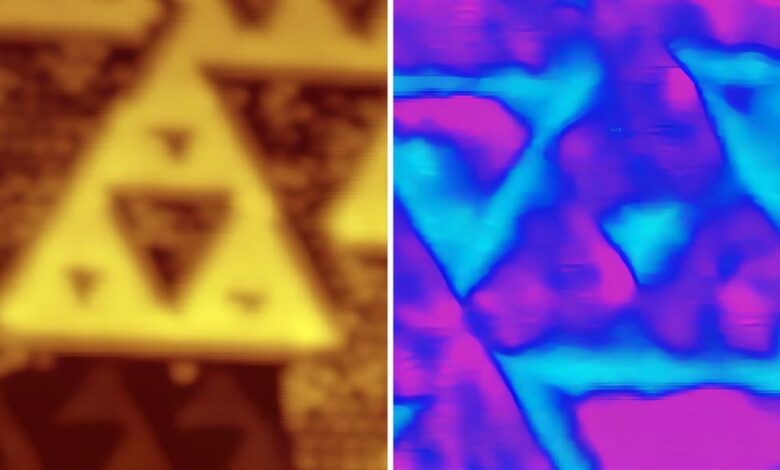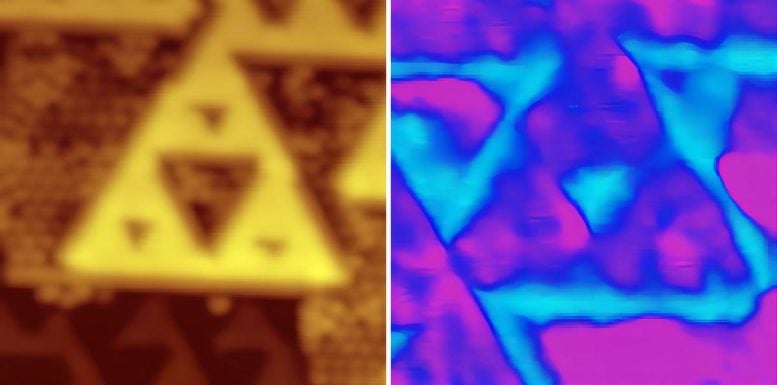1.58 Dimensions Unlock Zero-Loss Energy Efficiency


These photos were taken with a scanning tunneling microscope. Left: bismuth fractal (yellow) formed on top of indium antimonide (brown). The individual atoms are visible here. Right: the local density of electrons in a fractal. Credit: Utrecht University
Fractals might solve energy waste in information processing.
Topological insulators, capable of transmitting electricity without loss, may function in fractional dimensions such as 1.58. This breakthrough, combined with room-temperature operability, paves the way for advancements in quantum computing and energy efficiency through fractal structures.
What if we could find a way to make electric currents flow, without energy loss? A promising approach for this involves using materials known as topological insulators. They are known to exist in one (wire), two (sheet) and three (cube) dimensions; all with different possible applications in electronic devices. Theoretical physicists at Utrecht University, together with experimentalists at Shanghai Jiao Tong University, have discovered that topological insulators may also exist at 1.58 dimensions, and that these could be used for energy-efficient information processing. Their study was published recently in Nature Physics.
Classical bits, the units of computer operation, are based on electric currents: electrons running means 1, no electrons running means 0. With a combination of 0s and 1s, one can build all the devices that you use in your daily life, from cellphones to computers. However, while running, these electrons meet defects and impurities in the material, and lose energy. This is what happens when your device gets warm: the energy is converted into heat, and so your battery is drained faster.
A Novel State of Matter
Topological insulators are special materials that allow for the flow of a current without energy loss. They were only discovered in 1980, and their discovery was awarded a Nobel Prize. It revealed a new state of matter: on the inside, topological insulators are insulating, while at their boundaries, there are currents running. This makes them very suitable for application in quantum technologies and could reduce world energy consumption enormously. There was just one problem: these properties were discovered only in the presence of very strong magnetic fields and very low temperatures, around minus 270 degrees Celsius, which made them unsuitable for use in daily life.
Over the past decades, significant progress has been made to overcome these limitations. In 2017, researchers discovered that a two-dimensional, single-atom-thick layer of bismuth displayed all the right properties at room temperature, without the presence of a magnetic field. This advancement brought the use of topological insulators in electronic devices closer to reality.
Exploring Fractal Dimensions in Quantum Technology
The research field received an extra boost in 2022 with a Gravitation grant of more than 20 million euros for the QuMAT consortium. In this consortium, theoretical physicists of Utrecht University, together with experimentalists at Shanghai Jiao Tong University, have now shown that many states without energy loss might exist somewhere in between one and two dimensions. At 1.58 dimensions, for example.
It may be difficult to imagine 1.58 dimensions, but the idea is more familiar than you think. Such dimensions can be found in fractal structures, such as your lungs, the network of neurons in your brain, or Romanesco broccoli. They are structures that scale in a different way than normal objects, called “self-similar structures”: if you zoom in, you will see the same structure again and again.
Innovating at the Edge: Fractal Topological States
By growing a chemical element (bismuth) on top of a semiconductor (indium antimonide), the scientists in China obtained fractal structures that were spontaneously formed, upon varying the growth conditions. The scientists in Utrecht then theoretically showed that, from these structures, zero-dimensional corner modes and lossless one-dimensional edge states emerged.
“By looking in between dimensions, we found the best of two worlds,” says Cristiane Morais Smith, who has been leading the theoretical research at Utrecht University. “The fractals behave like two dimensional topological insulators at finite energies and at the same time exhibit, at zero energy, a state at its corners that could be used as a qubit, the building blocks of quantum computers. Hence, the discovery opens new paths to the long-wished qubits.”
The Power of Intuition in Scientific Discovery
Interestingly, the discovery was the result of a gut feeling. “When I was visiting Shanghai Jiao Tong University and saw the structures produced by the group, I got very excited,” Morais Smith says. “My intuition was telling me that the structures should exhibit all the right properties.”
She then got back to Utrecht and discussed the problem with her students, who were very interested to do the calculations. Together with master student Robert Canyellas, her former PhD candidate Rodrigo Arouca (now at Uppsala University), and current PhD candidate Lumen Eek, the theoretical team managed to explain the experiments and confirm the novel properties.
Uncharted Dimensions
In follow-up research, the experimental group in China will try to grow a superconductor on top of the fractal structure. These fractals have many holes, and there are lossless currents running around many of them. Those could be used for energy-efficient processing of information.
The structures also exhibit zero-energy modes at their corners, thus combining the best of the one-dimensional and two-dimensional worlds, according to Morais Smith. “If this works, it might reveal even more unexpected secrets hidden at dimension 1.58,” she says. “The topological features of fractals really show the richness of going into uncharted dimensions.”
Reference: “Topological edge and corner states in bismuth fractal nanostructures” by R. Canyellas, Chen Liu, R. Arouca, L. Eek, Guanyong Wang, Yin Yin, Dandan Guan, Yaoyi Li, Shiyong Wang, Hao Zheng, Canhua Liu, Jinfeng Jia and C. Morais Smith, 1 July 2024, Nature Physics.
DOI: 10.1038/s41567-024-02551-8




